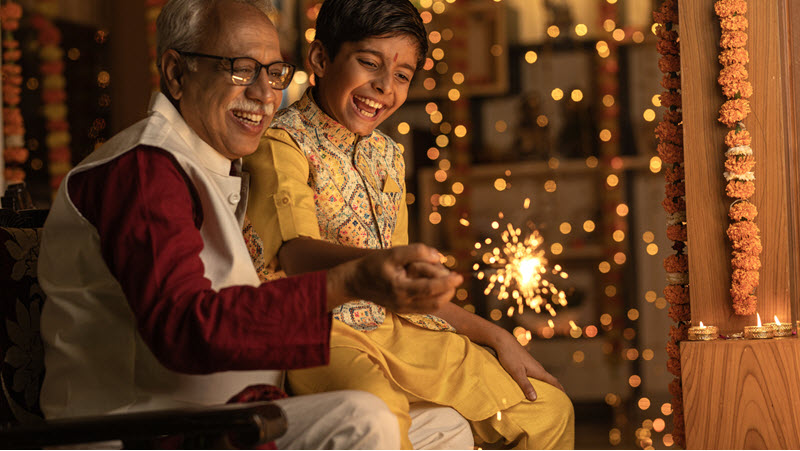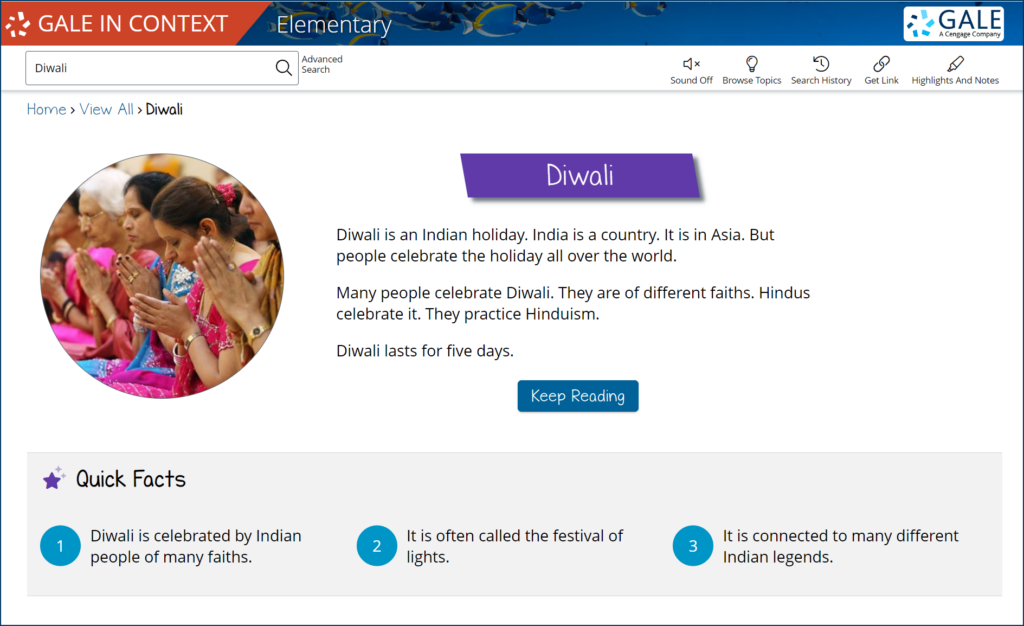| By Gale Staff |
Each autumn, more than a billion people in India and across the world light their diyas (clay lanterns) and gather with loved ones for Diwali, the festival of lights. This celebration brings families and communities together for five days of traditions and events in observance of the triumph of light over darkness and good over evil.
The specific dates of Diwali are based on the lunar calendar, rather than the solar or Gregorian calendar. This ensures that the third day falls on the darkest night of the Hindu month known as Kartika, ushering in the longest nights of the year with an outpouring of brilliant luminescence. Thus, 2024’s festivities will begin on Tuesday, October 29, with the height of the holiday on Friday, November 1.
In any classroom, students who observe Diwali may come from one of several religious backgrounds—Hinduism, Buddhism, Sikhism, or Jainism—each of which has its own beliefs associated with the holiday. For students who are not familiar with Diwali or Indian culture, teachers may wonder how to help young learners connect emotionally and intellectually with the festival while kindling a greater sense of global citizenship.
The Gale In Context: Elementary database is a one-stop shop for K-5 learners to explore trustworthy, media-rich, curriculum-aligned content from the most reputable publishers in education, including The Columbia Electronic Encyclopedia™, U.S. Kids, and CNN Wire. Within our simplified interface, students can kindle their curiosity about Diwali, Hinduism, India, and countless other topics with periodicals, book excerpts, more than 20,000 pictures, hundreds of videos, and exclusive kid-friendly infographics.
To complement these resources, teachers may consider structuring Diwali lessons around a pedagogically supported instructional strategy, such as an interactive read-aloud. The combination of Gale’s extensive learning resources and teacher-led storytelling provides students with a deeper, more nuanced understanding of the history and significance of cultural celebrations. Start with the Diwali topic page!
We’ve gathered resources—both storybook recommendations and Gale In Context: Elementary content—to help educators bring the Festival of Lights into their classrooms this fall.
Introduce the Festival of Lights to Elementary Learners
Starting the lesson with a general overview of the events that occur throughout the five-day holiday gives all students a consistent context for later activities.
Day 1: Dhanteras – On the first day of Diwali, Dhanteras, families clean their homes to garner the favor of Lakshmi, the goddess of wealth and prosperity. Once tidied, the living space is adorned with newly purchased utensils, jewelry, household appliances, and the like as a symbol of the family’s good fortune.
Day 2: Choti Diwali – Choti Diwali, sometimes referred to as Naraka Chaturdashi, honors Lord Krishna’s victory over the demon Narakasura. In recognition of evil’s defeat, the second day involves early morning rituals such as bathing in oil and lamp-lighting to symbolize the way that Lord Krishna dispelled darkness from the lands.
Day 3: Diwali – The third day is the main Diwali festival, during which families perform puja, or prayer rituals, to honor the goddess Lakshmi and ask her to bless their homes with prosperity and happiness.
Day 4: Govardhan Puja – Govardhan Puja, also known as Padva, is celebrated on the fourth day. This day marks Lord Krishna’s lifting of the Govardhan Hill to protect villagers from torrential rains. Families prepare vegetarian dishes and offer them to the deities.
Day 5: Bhai Dooj – On the final day of Diwali, the focus of the celebration is the bond among siblings. They give one another gifts and pray for each other’s health and happiness.
Read-Aloud Recommendation: Let’s Celebrate 5 Days of Diwali! by Ajanta Chakraborty and Vivek Kumar
“Go on an adventure with Maya, Neel, and their cute little partner, Chintu the squirrel, as they learn all about this famous Indian festival of lights including Dhanteras, Diwali sweets, Rangoli drawings, fireworks, and the special sibling bond of Bhai Dooj.”
Compare Diwali Traditions Across Religions
Recognizing the differences amongst Diwali-celebrating populations opens up a conversation about how families may have different traditions but can still appreciate and celebrate these festivities together.
Gale In Context: Elementary serves as a launching point not only for learning information about Diwali but also for exploring the foundations of other world religions in a historical and cultural context. Should teachers wish to extend this lesson, they can start from each religion’s main pages to discover additional pictures, readings, magazine articles, news pieces, biographies, and more on the topic.
Hinduism
In the Hindu religion, the origins of Diwali are told in the Ramayana, an ancient epic that tells the story of Prince Rama. Following a 14-year exile, during which Rama defeated the demon king Ravana, he returned to his home of Ayodhya as a hero. To celebrate his return and acknowledge the victory of light (goodness) over darkness (evil), the people of Ayodhya lit thousands of oil lamps to guide the prince, his wife Sita, and his brother Lakshmana home.
Buddhism
The Newar Buddhists of Nepal call the Diwali festival “Tihar” and see it as a commemoration of Emperor Ashoka’s conversion from Hinduism to Buddhism in the 3rd century BCE after witnessing the violence and bloodshed of the Kalinga War. He turned to the Buddhist teachings of non-violence and compassion, leading to the religion’s spread across Asia.
Sikhism
In Sikhism, Diwali coincides with Bandi Chhor Divas, the day in 1619 CE when Mughal Emperor Jahangir released the sixth Guru, Hargobind Ji, from prison. Ji is best remembered for refusing to leave his confinement until the emperor also agreed to release the 52 Hindu princes imprisoned with him. Similar to Rama’s story, the city of Amritsar celebrated his return to the Golden Temple by adorning the city in lights to show the triumph of justice.
Jainism
The main festival day of Diwali is also the day that Jains honor Lord Mahavira, the last of the religion’s 24 supreme spiritual teachers known as Tirthankaras. His time as a Tirthankara saw him refine the Jainist beliefs of his predecessors into the religion still practiced to this day, based on five core principles: Ahiṃsā (non-violence), satya (truth), asteya (not stealing), brahmacharya (celibacy), and aparigraha (non-possessiveness). It was through this dharmic path that Mahavira is said to have attained moksha, or liberation from the cycle of rebirth.
Read-Aloud Recommendation: Let’s Celebrate Diwali! by Anjeli Joshi
“Harini is excited to share her Diwali story during circle time at school. She quickly learns that she’s not the only one with a story to share! Join Harini as she learns about Hindu, Sikh, Jain, and Buddhist Diwali traditions.”
Identify Shapes and Patterns in Rangoli Designs
Intricately designed rangoli are temporary art pieces created from pigmented powders, rice, or sand and drawn on the entryway floors of a household to welcome Lakshmi, the goddess of wealth and prosperity, and her blessings of good luck. Within each rangoli are geometric shapes, symbolizing the stability and order of the universe.
Rangoli features bright, bold colors represented symmetrically throughout the designs. Elementary teachers may consider looking at examples of this cherished Indian folk art and leading the class as they point out particular patterns of color. Once they’re familiar with what rangoli look like, students can color their own pre-made templates by sprinkling colored salt on top of glue.
Read-Aloud Recommendation: Lilu’s Rangoli by Devika Joglekar
“One of Lilu’s Diwali gifts is a Rangoli book. So, she and her brother, Little Kuku have decided to try out a few designs from the book. Through wonderful, vibrant illustrations and sweet rhyming text, Lilu’s Rangoli teaches kids how to make Rangoli patterns, using colored sands and flowers.”
Interactive Read-Alouds & Gale In Context: A Powerful Pair for Cultural Explorations
Exposing young learners to diverse cultures and their holiday celebrations at an early age fosters an inclusive, empathetic worldview—made even more accessible by using storybooks to engage students in interactive read-alouds. The rich, colorful illustrations and relatable narrative structure give tangibility to abstract concepts, immersing them in the beauty and meaning of celebrations worldwide.
The benefits of interactive read-aloud sessions are supported by The Commission on Reading’s statement that “the single most important activity for building the knowledge required for eventual success in reading is reading aloud to children.” Research has long shown that engaging learners through this dialogic story time format “results in gains in vocabulary, comprehension strategies, story schema, and concept development.”
When combined with the resources available through the Gale In Context: Elementary, students can expand their horizons even further through related topics, in-depth research articles, and multimedia materials that promote respect for diversity and inclusivity.
Educators can contact their local sales representative to learn more about Gale In Context: Elementary.


